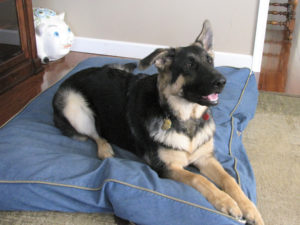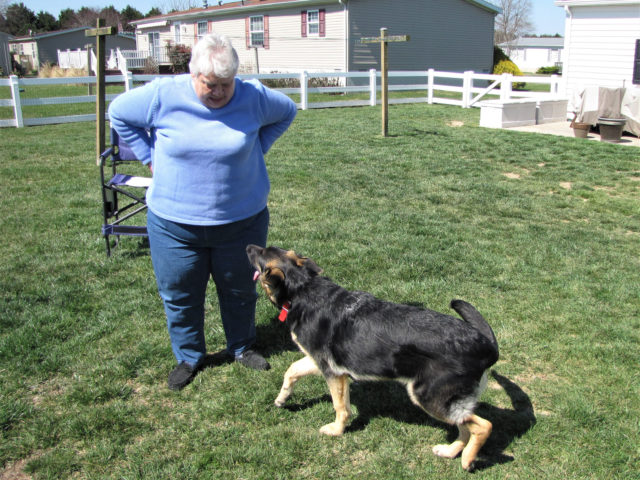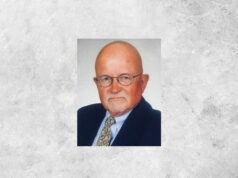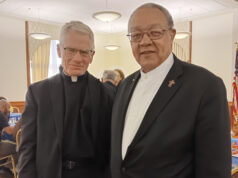Lewes, DE. – Every Sunday morning, Mugsy is a familiar sight at St. Jude the Apostle Church in Lewes.
The young German Shepherd sits in a corner in the back with his trainer Cheryl Matczak. Mugsy, a friendly five-month old, sits quietly, walks forward with Cheryl when she takes Communion and quietly returns to his corner.
He is quieter than many parishioners and his cell phone never rings during the homily.

The handsome young dog, usually with one ear flopped over, is a guide dog in training for Guiding Eyes for the Blind, a New York based group which places the dogs with people who need their help.
Cheryl is a “puppy raiser” for the organization, which means she rears the dogs for about 16-18 months, getting them used to noise, lights and people. They learn not to climb on the furniture, eat out of the garbage or chase the stray squirrel.
By the time, she’s done, they are socialized, well-behaved and ready for the next step. It’s a sort of canine charm school which gives them what she calls a “foundation”.
By the time they are paired with people, they will have become used to grates, elevators, vacuum cleaners and perhaps even the bustle of Times Square in New York City.
Dogs are placed individually with factors considered including how fast the person walks, whether they live in the city and whether the person takes the bus.
Most guide the blind, but others work with police or the ATF, sniff out drugs at airports or go into a breeding program. Matczak, with some help from husband Don, has raised 22 dogs. Margie worked at the Salt Lake City Olympics. Rodney is searching for explosives in Thailand.
This month, they will attend the graduation of a yellow lab named Sheldon, who will be paired with a man in the Philadelphia area. “They go all over,” she said.
Another dog named Ike works with a boy with autism. “Now he’s the cool kid with the dog and that’s worth a million dollars,” she said.
Matczak is retired from the National Geospacial Intelligence Agency while her husband is retired from the government printing agency.
She brings him to St. Jude because it is one more chance for him to get used to being around people. She sits quietly in the corner, in a wheelchair reserved for her, with him at her feet.
Mugsy does attract a lot of attention, especially from the youngest parishioners, but people quickly learn not to pet him during Mass, when he’s in training.
It’s like working guide dogs, who should not be petted while they are working.
“Taking him to church, he has to be quiet,” she said. “People respect him and he respects them.”
“He’s a puppy with a purpose, to be someone’s eyes, to give them independence and to be their best friend, just like he’s my best friend,” she said. “They literally teach them to walk in traffic … One day, he might save someone’s life. That person is literally putting his life in his hands.”
Matczak never wants to be a distraction and she told the parish staff that she didn’t need any special efforts. “Just put me in the back in a corner and I’m good,” she said.
There are a lot of rules and Mugsy has a lot to learn in a few months. But she bristles a bit when people say he’s not allowed to be a dog. “He runs in the yard. He plays in the house. When he’s here, he’s a dog,” she said.
Cheryl and Don dote on their animals and the affection is obvious. Mugsy lives with two other dogs and a very large basket of dog toys, although the other two dogs are pets. Cassie is a three-year-old shepherd rescued from a kill shelter. “She is the queen,” she laughed.
Flanders is a black lab who trained for the program, but was released because of a medical issue.
The trio especially enjoy going to the bank drive-through. They’ve learned that the air tubes which deliver cash, also dispense three dog treats. “They love going to the bank,” she said.
He goes to the post office, the library and often to schools to teach people about guide dogs. “I will hear kids say ‘Mom, you can’t pet that dog because he’s working,”’ she said.
The dogs are prepared almost from birth with regular handling, massage, blankets, exposure to lights and noise and regular human contact. Trainers get the dogs when they are about eight- to 10-weeks old.
Most dogs work nine to ten years and then become pets. There are nowhere near enough animals or puppy trainers to handle the demand, she said.
“They have all got a story. The dog gets them out in the world,” Don said.
They often attend graduations and sometimes stay in touch with the people partnered with the dogs. They speak about the dogs much like a parent with a child. “It’s pride. It’s a sense of accomplishment. It’s a pride in what the dog has become,” he said.
“It makes you realize everything you did is for a purpose,” she said.
Every 16 to 18 months, the phone rings and they are told it’s time for the dog to come back to New York to continue his training. That’s the hard part, but she tries to remember how much good the animals can do and how they can change lives.
“That’s when they break my heart,” she said.
For more information on Guiding Dogs for the Blind, go to guidingeyes.org or call 800-942-0149.








